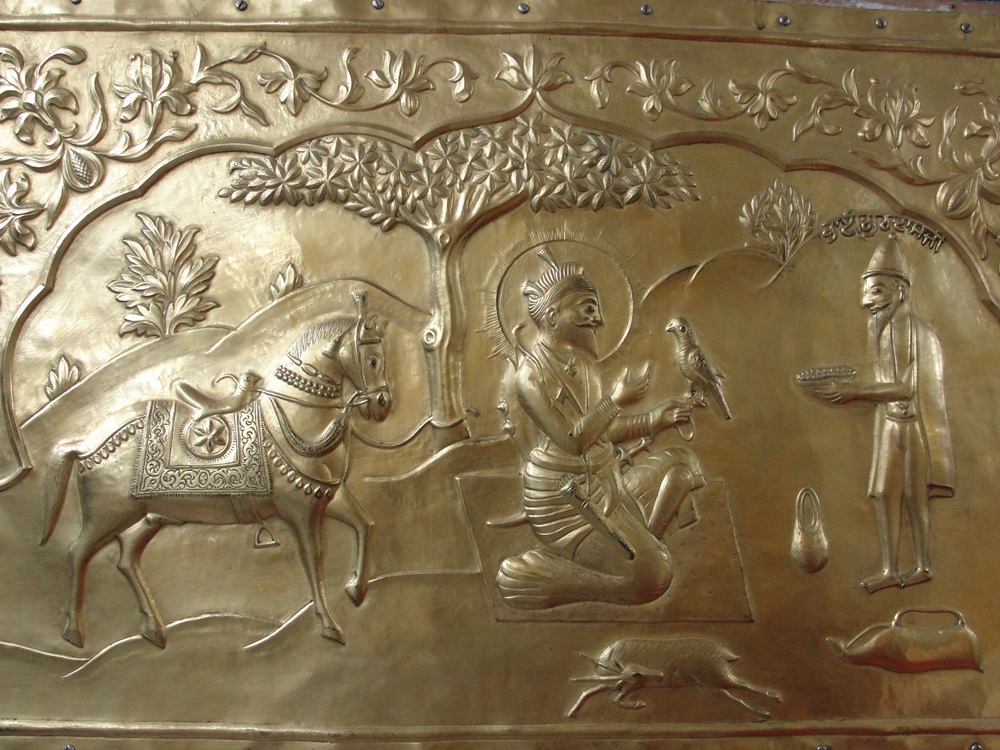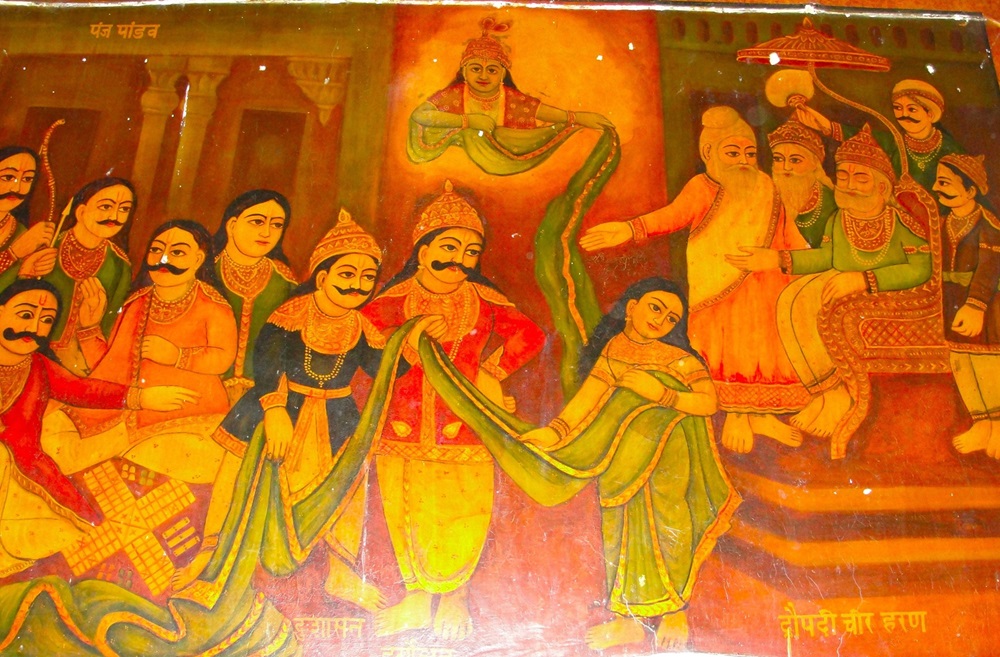
Written by: Zulfiqar Ali Kalhoro
Posted on: June 06, 2024 |  | 中文
| 中文
Kabir and Mai Loi in the Khatwari Darbar (Picture credits to Zulfiqar Ali Kalhoro)
There are three Khatwari Darbars in Shikarpur. The first and main one, also known as Khatwari Dharamshala, is located in Thekrati Bazar, second is on the same street, while the third is located opposite Balakram Ji Marhi near Lakhidar.
The main Khatwari Darbar, or Dharamshala, is one of the most impressive buildings in Shikarpur and is noted for its beautiful fresco paintings and woodworks. Such decoration is rarely seen in any other town in upper Sindh. The Khatwari Darbar is believed to have been founded by Kanhiya Lal, alias Bhai Gurdas, a disciple of Guru Gobind Singh. The Darbar was most likely built in the second quarter of the eighteenth century. Opposing versions of Kanhiya Lal exist among Shikarpur's Hindu community: some believe that there were two people named Kanhiya Lal, one from Shikarpur and the other probably from the Punjab.

Metal plate depicting Bhai Gurdas standing before Guru Gobind Singh (Picture credits to Zulfiqar Ali Kalhoro)
According to Munhijo Watan Munhija Mahnoon by Lok Ram Dodeja (1993), Kanhiya Lal Bhatia alias Bhai Gurdas Bhai was the founder of Khatwari Dharamsala in Shikarpur and a follower of Guru Gobind. Lok Ram Dodeja believes that when Guru Gobind Singh was fighting the army of Aurangzeb, he assigned various duties to his Khalsa Sikhs. Bhai Gurdas was entrusted with the responsibility of serving water to the injured Sikh soldiers, but he was found to be serving water to both the Muslim and Sikh wounded soldiers. According to Lok Ram Dodeja (1993:113), one of the Punjabi soldiers complained about Bhai Gurdas to Guru Gobind Singh that a Sindhi Sikh was also serving water to their enemies. Guru Gobind Singh understood that he was a mystic. It is important to note that Lok Ram Dodeja called Bhai Gurdas a Sindhi, whereas, in other accounts he is referred to as having been born in a village of Sialkot, and not Sindh.
When Guru Gobind Singh discovered that he was serving water to the enemy, instead of reprimanding him, he instructed him to preach the Sikh religion in Shikarpur. Following the instructions of his Guru, Bhai Gurdas started preaching the Sikh religion in Shikarpur. He used to sit on a cot while delivering lectures and sermons. Thus, the khat (cot) appellation was used, and the darbar became known as Khatwari Darbar. There is another version of the story: some people I interviewed in Shikparpur believed that Bhai Gurdas first came to Gandava, Balochistan, from where he preached to other parts of Balochistan and Sindh. After Gandava, he preached the Sikh religion in Shikarpur, where later on, his disciples built an impressive Khatwari Dharamshala. It is also believed that Bhai Gurdas visited Shahdadkot town in Sindh, where Khatwari Darbar is also located. He was known as Khatwaro Bao (ascetic) in Sindh.
I have also visited the Khatwari Darbar of Gandava town in Jhal Magsi district, which is noted for intricate wood carvings representing Krishna, Ganpati and Guru Nanak, with his companions Bhai Mardana and Bhai Bala. The wooden façade of the Khatwari Darbar of Gandava is remarkable, with refined wood carvings that are not seen elsewhere in any temple or darbar in Balochistan.
Originally, Khatwari Darbar of Shikarpur was a five-storeyed building. Now, only two storeys remain. The darbar had a vast area associated with it, which has now been reduced to a few buildings. In front of the darbar was the Vidyalaya (school), which has now been rebuilt and serves as a charity hospital. There were also wells in the Darbar that catered to the needs of the pilgrims, who used to stay in the Dharamshala.
There are two main entrances to the Khatwari Darbar: the first entrance depicts a marble image of Durga, and on the second entrance, one finds a marble image of Ganpati flanked by his two wives. As one enters the Khatwari Darbar, one notices on the left a marble image of Varu Dev, also variously known as Jhulelal, Odero Lal, Amar Lal, Darya Shah, Darya Pir to Hindus and Zinda Pir and Khwaja Khizr to the Muslims. The Gurmukhi script has the name of the donor and the year Samvat 1984/ 1927 in which it was donated.
The Khatwari Darbar is built in the haveli style, with a courtyard and a verandah. The marble pillars, wooden balustrades and painted wooden ceilings of the verandah and hall are beautifully made. The verandah of the darbar is placed with pictures of the Gaddisars (custodians) of the Khatwari Darbar. Previously, the images were placed under a wooden canopy near a central wooden door, while three wooden doors opened to the main hall of the Khatwari Darbar. All three wooden doors depict figures of Hindu and Sikh deities and Gurus respectively. The central door has ten panels depicting Sikh Gurus and saints. One of the panels also shows figures, Baba Sewa Das and Baba Kashi Das. The door's wooden frame represents the figures of Vishnu with his vehicle (vahana), Garuda. To the right of the central door is another wooden door that is noted for the depiction of the Anantashayana Vishnu, who is shown reclining on the multi-headed serpent Shesha (Ananta) amidst the cosmic ocean, with his consort Goddess Lakshmi seated at his feet. Four-headed Brahma is shown to be sitting on a lotus that springs from Vishnu’s naval. The image of Anantashayana Vishnu is a recurring motif in Shikarpur's wall paintings and woodwork.
To the left of the central wooden door is another one that represents a delicately engraved Krishna flanked by cows and the Gopas (cow herders), reflecting the mastery of Shikarpur artisans in woodcarving. The hall of Khatwari Darbar houses the Guru Granth Sahib, the image of Sri Chand, Guru Nanak's eldest son and Jhulelal’s Jyot (light). The walls are adorned with paintings representing themes from the Ramayana, Mahabharata, Bhagavata Purana, Vishnu Purana, Bhagavad Gita, Gita Govinda, etc. The paintings also depict Hindu kings and heroes who fought the Mughals. Moreover, depictions of sants (saint-poets) are also painted. The hall also represents Sikh gurus, saints and heroes. The painting of Bhai Gurdas or Khatwaro Bao, after whom the darbar is named, is painted on a hall wall.
One of the panels shows three deities: Vishnu, Shiva and Brahma. In addition to this Hindu Trimurti, there are depictions of Hindu goddesses, including Durga, Sarasvati and others. Some of the incarnations (avatars) of Vishnu, Krishna, Rama, Narasimha, Vamana and Kurma are painted on the walls of the various halls. On one of the panels, Krishna is shown playing a flute accompanied by cows, while the prominent panel in the hall depicts all ten Sikh gurus together.
The Mahabharata themes are also portrayed. One panel shows Krishna driving a chariot with Arjuna during the Battle of Kurukshetra also known as the Battle of Mahabharata, fought between the Kauravas and the Pandavas. There is also a painting of Varun Dev/Jhulelal seated on a throne with a sacred book in his hand. The throne stands over his vahana (mount/vehicle) and the palla fish. Another panel shows Banda Bahadur, a saint warrior who joined the 10th Sikh Guru Gobind Singh in his wars against the Mughal king Aurangzeb. Banda Bahadur's real name was Lachman Dev, who became a disciple of Guru Gobind Singh and who named him Banda Singh Bahadur.
Maharana Pratap (d.1597), the ruler of Mewar, is also painted on a wall of Khatwari Darbar’s hall, who also fought the Mughals. In popular Indian culture, he is hailed as an inspirational figure who exemplified gallantry. The Hindu king Shivaji (d. 1680) is depicted on a wall of the Khatwari Darbar, who successfully fought the Mughals and founded the Maratha kingdom.
Kabir, an Indian mystic poet and saint whose writings influenced Hinduism's Bhakti movement, is also painted in the Khatwari Darbar. He is shown weaving while his wife, Mai Loi, is shown spinning. This theme also captured the imagination of Sindhi painters, who painted Bhagat Kabir and Mai Loi in many temples and darbars in Sindh. In Shikarpur, a few temples and darbars still depict Bhagat Kabir.
A wall of the hall is painted with Draupadi Cheer Haran, or the disrobing of Draupadi. This painting shows Duryodhana's brother, Dushasana, forcibly attempting to disrobe Draupadi in the centre of the Kaurava court. As legend has it, Draupadi's husbands, the Pandavas, who have lost her and their kingdom in a crooked game of dice, sit helplessly, as shown in the painting. As Dushasana repeatedly tries to strip Draupadi, Krishna's divine grace provides her with an unending garment, thus sparing her further humiliation.

The disrobing of Draupadi and unending garment given by Krishna (Picture credits to Zulfiqar Ali Kalhoro)
Apart from the depiction of the disrobing of Draupadi, the Naraka (hell) scene is represented in Khatwari Darbar. The painting portrays Yama, the god of death, seated on a throne while to the left stands a demon. To the right of Yama sits Chitragupta, assigned to keep detailed records of every human being and, upon their death, decide how they will be reincarnated, depending on their previous actions. In the painting, the wrongdoers are shown being punished according to their sins committed. This is the most interesting painting. One cannot find Naraka paintings in any other temple in Shikarpur, not even in any other temple in Sindh. However, the Naraka scene is represented in a marble panel on the northern wall of Baba Bankhandi Darbar at Sadh Belo in Sukkur.
Samudra Mathan (churning of the ocean of milk) is another theme that is painted in Khatwari Darbar. The Puranic legend Gajendra Moksha (the liberation of an elephant) scene is also depicted on the Hall’s wall. The coronation of Rama (seventh avatar of Vishnu) by Sage Vasishtha is portrayed in the Khatwari Darbar. Rama is seated with Sita on the throne under a bejeweled canopy. Rama’s forehead is being anointed with the sacred tilak by the sage Vasishtha. This scene of the coronation of Rama also shows the brothers of Rama, and Hanuman is also depicted.
Several other paintings are also in the hall. Two metal plates are on the walls of a small temple dedicated to Vishnu within the hall of the Khatwari Darbar. The first metal plate depicts Baba Atal Rai Ji (son of Guru Hargobind) with Seva Das, Kashi Das, Bhai Salo Ji and Mohan near the chair of Baba Atal Sahib. The second plate shows Bhai Gurdas standing before Guru Gobind Singh. Paintings, wooden doors and ceilings all reflect the affluence of Shikarpur's wealthy merchants, who lavishly spent money on the construction and ornamentation of the Khatwari Darbar. After Partition, a branch of Khatwari Darbar was also built in Mumbai, India.
The writer is an anthropologist. He has authored 15 books on Pakistan's cultural heritage and anthropology. He tweets @kalhorozulfiqar
You may also like: